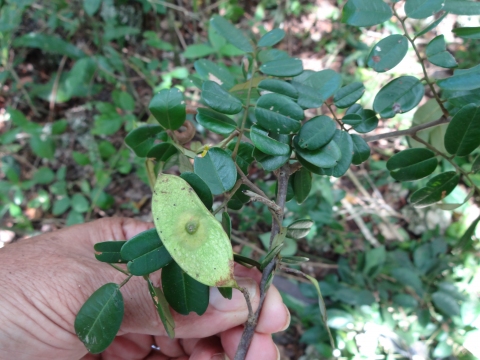Dalbergia glabra
(Mill.) Standl.
Fabaceae
Dalbergia campechiana Benth.
Dalbergia perpusii Brandegee
Dalbergia tabascana Pittier
Robinia glabra Mill.
Common Name:

Leaf and seedpod
Photograph by: Walocruz
Creative Commons Attribution-Share Alike 3.0

Leaf and seedpod
Photograph by: Walocruz
Creative Commons Attribution-Share Alike 3.0

Leaf
Photograph by: Walocruz
Creative Commons Attribution-Share Alike 3.0
General Information
Dalbergia glabra is rather variable in habit, ranging from a large shrub or small tree to adopting a scandent habitat and becoming a large vine[
331- Title
- Flora of Guatemala
- Publication
-
- Author
- Standley P.C. & J. A. Steyermark
- Website
- http://www.archive.org/
- Publisher
-
- Year
- 1946 - 1976
- ISBN
-
- Description
- A superb reference, though somewhat dated. Gives lots of plant uses as well as information on plant habit and habitat. The entire flora (13 volumes) can now be downloaded from http://www.archive.org/
].
The plant is harvested from the wild for its inner bark, which is used locally for cordage[
331- Title
- Flora of Guatemala
- Publication
-
- Author
- Standley P.C. & J. A. Steyermark
- Website
- http://www.archive.org/
- Publisher
-
- Year
- 1946 - 1976
- ISBN
-
- Description
- A superb reference, though somewhat dated. Gives lots of plant uses as well as information on plant habit and habitat. The entire flora (13 volumes) can now be downloaded from http://www.archive.org/
].
Known Hazards
None known
Botanical References
331- Title
- Flora of Guatemala
- Publication
-
- Author
- Standley P.C. & J. A. Steyermark
- Website
- http://www.archive.org/
- Publisher
-
- Year
- 1946 - 1976
- ISBN
-
- Description
- A superb reference, though somewhat dated. Gives lots of plant uses as well as information on plant habit and habitat. The entire flora (13 volumes) can now be downloaded from http://www.archive.org/
Range
Central America - southern Mexico to Honduras.
Habitat
Dry to wet thickets or in thin forest, at elevations of 900 metres or less[
331- Title
- Flora of Guatemala
- Publication
-
- Author
- Standley P.C. & J. A. Steyermark
- Website
- http://www.archive.org/
- Publisher
-
- Year
- 1946 - 1976
- ISBN
-
- Description
- A superb reference, though somewhat dated. Gives lots of plant uses as well as information on plant habit and habitat. The entire flora (13 volumes) can now be downloaded from http://www.archive.org/
].
Properties
| Other Uses Rating |      |
| Habit | Shrub |
| Height | 5.00 m |
| Cultivation Status | Wild |
Cultivation Details
A plant of lower elevations in the tropics.
Species in this genus are mainly found in the wild growing in sany soils and on limestone escarpments[
200- Title
- The New RHS Dictionary of Gardening. 1992.
- Publication
-
- Author
- Huxley. A.
- Publisher
- MacMillan Press
- Year
- 1992
- ISBN
- 0-333-47494-5
- Description
- Excellent and very comprehensive, though it contains a number of silly mistakes. Readable yet also very detailed.
]. In cultivation they are likely to do well in a fertile, loam soil and a position in full sun[
200- Title
- The New RHS Dictionary of Gardening. 1992.
- Publication
-
- Author
- Huxley. A.
- Publisher
- MacMillan Press
- Year
- 1992
- ISBN
- 0-333-47494-5
- Description
- Excellent and very comprehensive, though it contains a number of silly mistakes. Readable yet also very detailed.
].
This species has a symbiotic relationship with certain soil bacteria, these bacteria form nodules on the roots and fix atmospheric nitrogen. Some of this nitrogen is utilized by the growing plant but some can also be used by other plants growing nearby[].
Edible Uses
None known
Medicinal
None known
Other Uses
The tough inner bark is used as cordage[
331- Title
- Flora of Guatemala
- Publication
-
- Author
- Standley P.C. & J. A. Steyermark
- Website
- http://www.archive.org/
- Publisher
-
- Year
- 1946 - 1976
- ISBN
-
- Description
- A superb reference, though somewhat dated. Gives lots of plant uses as well as information on plant habit and habitat. The entire flora (13 volumes) can now be downloaded from http://www.archive.org/
].
Propagation
Like many species within the family Fabaceae, once they have been dried for storage the seeds of this species may benefit from scarification before sowing in order to speed up germination. This can usually be done by pouring a small amount of nearly boiling water on the seeds (being careful not to cook them!) and then soaking them for 12 - 24 hours in warm water. By this time they should have imbibed moisture and swollen - if they have not, then carefully make a nick in the seedcoat (being careful not to damage the embryo) and soak for a further 12 hours before sowing[
K- Title
- Plants for a Future
- Author
- Ken Fern
- Description
- Notes from observations, tasting etc at Plants For A Future and on field trips.
].
Softwood cuttings of many species, especially if taken from younger plants, will root in a well-drained, sandy medium in a closed case with bottom heat[
200- Title
- The New RHS Dictionary of Gardening. 1992.
- Publication
-
- Author
- Huxley. A.
- Publisher
- MacMillan Press
- Year
- 1992
- ISBN
- 0-333-47494-5
- Description
- Excellent and very comprehensive, though it contains a number of silly mistakes. Readable yet also very detailed.
].
If you have any useful information about this plant, please leave a comment. Comments have to be approved before they are shown here.
 Useful Tropical Plants Database 2014 by
Ken Fern,
web interface by
Ajna Fern
with help from
Richard Morris.
Useful Tropical Plants Database 2014 by
Ken Fern,
web interface by
Ajna Fern
with help from
Richard Morris.